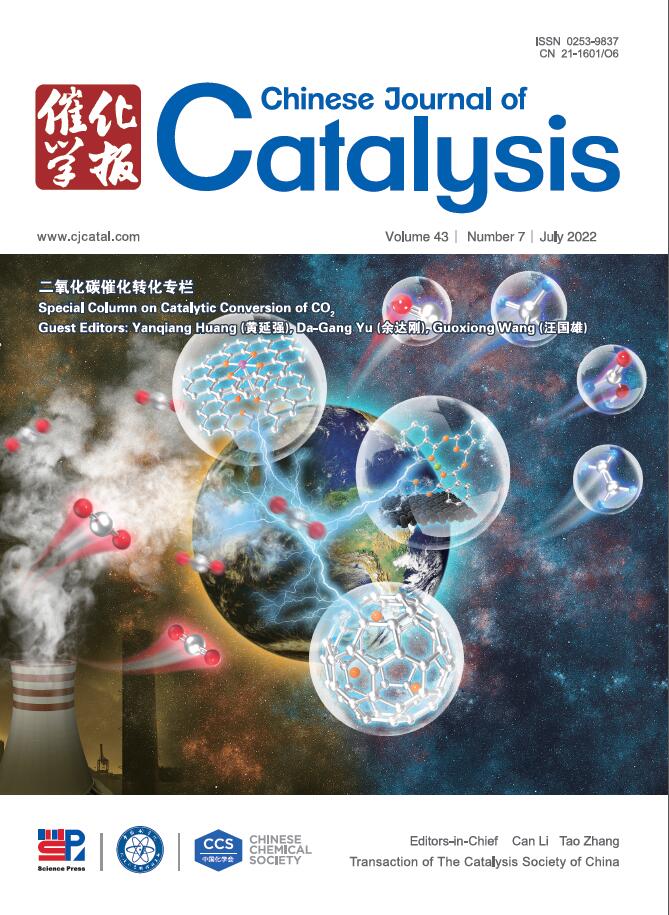设计了通过Fe-O-Ni原子键的电子传递路径,用于高CO2还原
IF 15.7
1区 化学
Q1 CHEMISTRY, APPLIED
引用次数: 0
摘要
将不同的金属有机骨架(mof)组装成杂化异质结构是一种很有前途的策略,可以有效地突破单一金属位点的有限调节能力。本文以具有定向电子传递通道的超薄Ni-MOF和Fe-MOF纳米颗粒为基础,基于同源配体(1,4-邻苯二甲酸)制备了一种S-scheme异质结构(Fe3Ni-MOF),并将其用于CO2的光还原。在s型电场机制下,光生载流子可以通过Fe-O-Ni原子键实现高效的定向分离,显著降低了速率决定步骤的能量势垒。结果表明,Fe3Ni-MOF (63.5 μmol g-1)的性能分别是Ni-MOF和Fe-MOF的20倍和3.2倍,并具有良好的CO选择性(96.4%)和稳定性。透射电子显微镜和原子力显微镜显示了Ni-MOF的两分子层结构和Fe3Ni-MOF的微组装结构,缩短了电子传递距离,提高了分子传质速率。x射线光电子能谱、电子自旋共振和电子密度差计算表明,界面电场和原子键共同作用促进了载流子的定向分离,导致Ni-MOF上空穴和Fe-MOF上电子的积累。Gibbs自由能计算和原位傅里叶变换红外光谱验证了具有定向电子传递通道的微组装s型异质结构可以显著降低反应的活化能垒。本研究不仅证明了利用同源配体构建MOFs -scheme异质结构的可行性,而且为克服单金属mof的局限性提供了新的途径。这一策略有望为设计高效光催化剂开辟一条新途径。本文章由计算机程序翻译,如有差异,请以英文原文为准。
Designed electron transport path via Fe–O–Ni atomic bond for high CO2 reduction
The assembly of different Metal organic framework (MOFs) into hybrid heterostructures has proven to be a promising strategy that can effectively break through the limited regulatory capacity of single metal sites. Here, an S-scheme heterostructure (Fe3Ni-MOF) based on homologous ligands (1,4-phthalic acid) of ultra-thin Ni-MOF and Fe-MOF nanoparticles with directional electron transport channels, was developed and used it for photoreduction of CO2. Under the S-scheme electric field mechanism, the photogenerated carrier can achieve efficient directional separation through Fe–O–Ni atomic bond, which significantly reduces the energy barrier of the rate-determining step. Results show that the performance of Fe3Ni-MOF (63.5 μmol g–1) was 20 and 3.2 times higher than that of Ni-MOF and Fe-MOF, respectively, and exhibits excellent CO selectivity (96.4%) and stability. Transmission electron microscopy and atomic force microscopy revealed the two-molecular-layers structure of Ni-MOF and the micro-assembly structure of Fe3Ni-MOF, which can shorten the electron transport distance and increase the molecular mass transfer rate. X-ray photoelectron spectroscopy, electron spin resonance and electron density difference calculations reveal that interfacial electric fields and atomic bonds work together to promote directional carrier separation, resulting in the accumulation of holes on Ni-MOF and electrons on Fe-MOF. The Gibbs free energy calculation and in-situ Fourier transformed infrared spectroscopy validate that the micro-assembled S-scheme heterostructures with directional electron transport channels can significantly reduce the activation energy barrier of the reaction. This study not only proves the feasibility of constructing MOFs S-scheme heterostructures using homologous ligands, but also provides a new way to overcome the limitations of monometallic MOFs. This strategy is expected to open up a new avenue to design efficient photocatalysts.
求助全文
通过发布文献求助,成功后即可免费获取论文全文。
去求助
来源期刊

Chinese Journal of Catalysis
工程技术-工程:化工
CiteScore
25.80
自引率
10.30%
发文量
235
审稿时长
1.2 months
期刊介绍:
The journal covers a broad scope, encompassing new trends in catalysis for applications in energy production, environmental protection, and the preparation of materials, petroleum chemicals, and fine chemicals. It explores the scientific foundation for preparing and activating catalysts of commercial interest, emphasizing representative models.The focus includes spectroscopic methods for structural characterization, especially in situ techniques, as well as new theoretical methods with practical impact in catalysis and catalytic reactions.The journal delves into the relationship between homogeneous and heterogeneous catalysis and includes theoretical studies on the structure and reactivity of catalysts.Additionally, contributions on photocatalysis, biocatalysis, surface science, and catalysis-related chemical kinetics are welcomed.
 求助内容:
求助内容: 应助结果提醒方式:
应助结果提醒方式:


